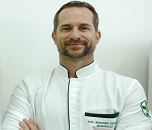Scientific Program

Alexandre Ehrhardt
Medical Laboratory Scientist, Brazil
Title: Glass ionomer cement modified by a imidazolium salt: adding antifungal properties to a biomaterial
Biography:
Alexandre Ehrhardt is an Adjunct Professor with a demonstrated history of working in Clinical Laboratory. Skilled in Toxicology and Pharmacology, Immunology and Hematology. Hold a strong professional education with a Master Degree in Pharmacology and Therapeutics focused in Development of Bioactives Compounds from Universidade Federal do Rio Grande do Sul (Brasil). Currently is developing a project focusing on Biomaterials with antibacterial and antifungal activity.
Abstract
A plethora of bacteria and fungi are able to alternate planktonic growth and community growth, commonly referred as biofilms. Orthodontic appliances favors the colonization by Candida albicans yeasts (C. tropicalis, C. parapsilosis and C. krusei) in the saliva of individuals with or without clinical manifestations of candidiasis. The concern of biofilm formation during orthodontic treatment, associated with dental plaque formation and periodontal diseases is of concern considering that Candida spp. biofilms have a great resistance to antifungal drugs according to several studies. In order to minimize this problem, it is proposed to add antifungal properties to a biomaterial by modifying a glass ionomer cement with the addition of an imidazolium salt: C16MImCl. The process consisted of an structural modification of a commercially available glass ionomer cement by inserting the imidazolium salt 1-n-hexadecyl-3-methylimidazolium chloride (C16MImCl), generating a new biomaterial with antifungal biofilm activity. Test specimens were prepared using a commercial glass ionomer cement to which 10 ppm of cetylpyridinium chloride (CPC) as a reference ionic antifungal agent and C16MImCl were added. The feasibility and hypoallergenicity of the new biomaterial were assessed by microhardness plastic deformation and chorioallantoic membrane assays. Colony counting and SEM images evaluated the modified specimens’ antibiofilm activity against three multidrug-resistant Candida species. The modified glass ionomer cement presented a strong antibiofilm activity against Candida spp., without losing its original micromechanical and hypoallergenic properties. A good biofilm penetration was observed, breaking the fungal protection and characterizing an antifungal effect even at very low concentrations.
- Cancer Pharmacology
- Cardiovascular Pharmacology
- Clinical Pharmacology
- Network Pharmacology
- Invitro and Invivo Drug Delivery Techniques
- Chemotherapy
- Digital Pills-Pharmaceutical Technology
- Pharmacology-Pharmacokinetics & Pharmacodynamic approach
- Animal Pharmacology

